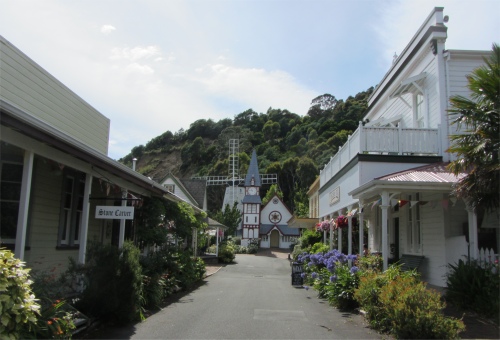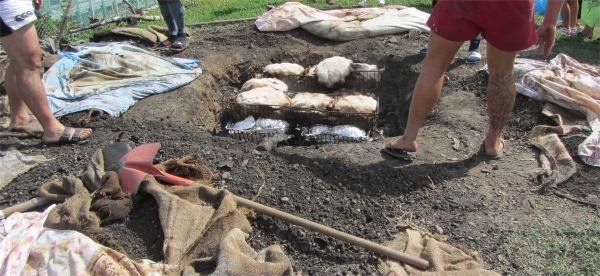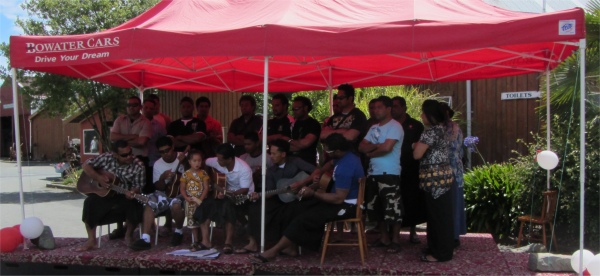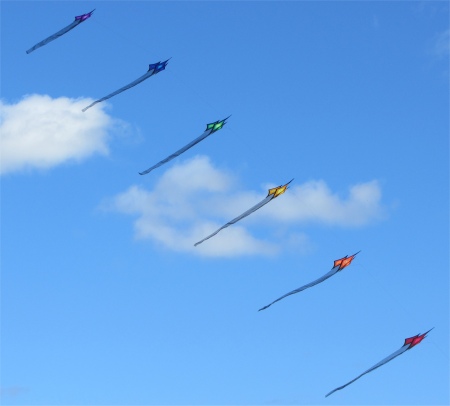 A Founders Heritage Street |
I headed off quite early to the opposite side of the city, passing Rutherford Street on the way. It was quite appropriate to have a street named after that famous fellow. Brightwater, near Nelson, was the birthplace of Lord Rutherford, the Nobel Prize-winning physicist who successfully split the atom. His image appears on New Zealand's $100 banknote, the largest denomination in circulation in the country.
My destination was Founders Park. The generous donation of $50k by the Newman family in 1976, to back their concept of a Nelson Regional Transport Museum, sowed the seed of today's Founders Heritage Park. The following year a Board of Trustees was established and by 1980 the Nelson City Council had approved the land for the Park. Filled to a depth of 3-4m with city waste, capped with clay from Walters Bluff, the allocated landfill site required much engineering work to prepare it for development.
Created with a combination of community skills, unemployed labour directed from the Labour Department, community service clubs, local businesses and a raft of volunteers, Founders officially opened in 1986. During the early period of development which included extensive landscape gardening, many historic buildingd were relocated to Founders while others were replicated. Following a period of uncertainty, the Nelson City Council assumed control in 1995.
 Bristol Merchant Buccaneer |
Like St Ives in the UK, the quality of light drew painters and potters to the city like a magnet. Nelson was now a centre for arts and crafts. Galleries and artists' studios housed work made from glass, metal, stone, wood, clay, sand, paper, ink, paint and fabric. Each year the city hosted popular events such as the Nelson Arts Festival. The annual Wearable Art Awards began near Nelson and a museum, World of Wearable Art, was housed close to Nelson Airport, showcasing winning designs.
 Hangi Being Uncovered |
What surprised me was seeing a Bristol Merchant Buccaneer (a plane for the uninitiated) parked up on an area of grass. This landed on the Wakapuaka mudflats in 1986 before being stripped of its wings and tail plane and towed by road into Founders Park. It is one of four remaining Bristols in New Zealand, another one being on display at the Omaka Aerodrome in Blenheim.
Merchant Buccaneer was the last Bristol flying in Straits Air Force Express (SAFE) colours. It started its 33 year flying career with the Pakistani Air Force in 1953, and purchased by SAFE and flown over to New Zealand in 1966 to uphold "Airmail" and interisland freight contracts.
 Maori Singsong |
At the end of the park, a path covered in trampled sea shells took me through to Whakatu Marae, an area of cabins inhabited by Maori. On a slight rise to one side, I watched a small group of Maori men, all leaning on shovels and stroking their chins, in deep debate about something. Close to where I was standing, I could overhear a group of Maori women setting up stalls. "It's only been cooking for 4 hours," said one of them, "we will have to microwave it."
Then I twigged, the Maori men were standing over a fully charged hangi pit. In a short while the men started to shovel away the mass of ash and charcoal to recover the treasure hidden below. The deeper they dug, the more steam started to rise, and the fiercer the heat was on their bodies.
 Not Quite the Red Arrows |
I gave it half an hour before I tried the hangi. It comprised steamed potatoes, sweet potatoes, lamb, stuffing, and a little chopped up salad. The meat was a little tough, but overall I enjoyed the meal. This Maori area where I sat eating was full of bonhomie, a festival for all.
The sun was now baking hot, and I was searching for shade. I nipped into the Founders Microbrewery to try half a pint of Red Head, a very pleasant ale. While I was queuing, I heard a voice from further behind, "It's the man from the boat trip." I turned around to see the couple I had met on the water taxi on my trip up to Torrent Bay. We sat with our drinks at the same table, and I mentioned to them that Bas had told me the previous evening that he thought the education system was too simple, hoping to pick up the conversation that we had begun 3 days earlier. "Yes, the British degrees are recognised in New Zealand, but Britain doesn't recognise the New Zealand degrees," said the woman. Her husband added, "It wasn't just education that took us back to the UK, my father was ill at the time, and I couldn't progress any further in my job since I wasn't a Kiwi."
The couple had a week left before they returned back to snowy Britain, and the man's wife was a little despondent at the thought. However, she brightened up when her son walked in with his Maori wife, to drag the couple off to the powhiri "greeting ceremony". I too went off and found a stage where a group of Maori were ready to perform. They went through similar songs (as far as I could tell), and dances that I had witnessed at Waitangi a couple of months ago. With their clear melodic voices, they were a pleasure to listen to, and all sung with a smile.

